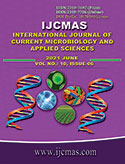


 National Academy of Agricultural Sciences (NAAS)
National Academy of Agricultural Sciences (NAAS)

|
PRINT ISSN : 2319-7692
Online ISSN : 2319-7706 Issues : 12 per year Publisher : Excellent Publishers Email : editorijcmas@gmail.com / submit@ijcmas.com Editor-in-chief: Dr.M.Prakash Index Copernicus ICV 2018: 95.39 NAAS RATING 2020: 5.38 |
Coronavirus disease 2019 (COVID-19) caused by severe acute respiratory syndrome coronavirus 2 (SARS-CoV-2) was first reported in China and rapidly spread worldwide. WHO declared this as a pandemic on March 11, 2020. This new virus belongs to the same family of viruses as SARS-CoV associated with civet cats, and MERS-CoV associated with dromedary camels.SARS-CoV-2 is known to infect pet animals, domestic and wild animals in addition to humans. Bats are shown to be the reservoir host and snakes as well as pangolins are suggested to be the intermediate hosts of this virus. Pet dogs and cats have tested positive in various countries. In addition to these animals, lions, tigers, ferrets and minks were also infected. Although it is still not certain that humans can transmit COVID-19 to their pets or other animals, whether mutated SARS-CoV-2 can affect animals, it is recommended to follow some preventive measures and basic animal hygiene. There is no literature proving the transmission of the virus from the infected pets to their owners. However, social distancing needs to be maintained with animals as with humans. By doing so, we can reduce the human as well as zoonotic transmission of SARS-CoV-2.
 |
 |
 |
 |
 |